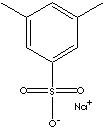| SODIUM
XYLENESULFONATE
|
||
|
PRODUCT IDENTIFICATION |
||
| CAS NO. | 1300-72-7 |
|
| EINECS NO. | 215-090-9 | |
| FORMULA | (CH3)2C6H3.SO3Na | |
| MOL WT. | 208.24 | |
|
H.S. CODE |
||
| TOXICITY | ||
| SYNONYMS | Xylenesulfonic acid, sodium salt; Sodium m-xylenesulfonate; | |
| Dimethylbenzenesulfonic acid, sodium salt; Sodium Dimethylbenzenesulfonate; | ||
| SMILES | ||
|
CLASSIFICATION |
|
|
|
PHYSICAL AND CHEMICAL PROPERTIES |
||
| PHYSICAL STATE | Light Yellow liquid | |
| MELTING POINT |
27 C |
|
| BOILING POINT | 157 C | |
| SPECIFIC GRAVITY | 1.23 | |
| SOLUBILITY IN WATER | ||
| pH | 7 - 10 (3% Sol.) | |
| VAPOR DENSITY | ||
|
AUTOIGNITION |
|
|
|
NFPA RATINGS |
Health: 1; Flammability : 0 ; Reactivity: 0 | |
|
REFRACTIVE INDEX |
|
|
| FLASH POINT |
|
|
| STABILITY | ||
|
GENERAL DESCRIPTION & APPLICATIONS |
||
| Sulfonic acid is a compound with general formula RSO2OH, where R is an aliphatic or aromatic hydrocarbon. It is a derivative of sulfuric acid (HOSO2OH) where an OH has been replaced by a carbon group or a compound where a hydrogen atom has been replaced by treatment with sulfuric acid; for example, benzene is converted to benzenesulfonic acid (water-soluble). Sulfonic acid has a sulfur atom bonded to a carbon atom of a hydrocarbon and bonded also to three oxygen atoms, one of which has been attached to a hydrogen atom. Sulfonic acid is acidic due to the hydrogen atom, stronger than a carboxylic acid. Sulfonic acid is one of the most important organo sulfur compounds in organic synthesis. Sulfonic acids are used as catalysts in esterification, alkylation and condensation reactions. Sulfonates are salts or esters of sulfonic acid. Sulfonic salts are soluble in water. Sulfonic acid and its salts present in organic dyes provide useful function of water solubility and or improve the washfastness of dyes due to their capabiltity of binding more tightly to the fabric. They are widely used in the detergent industry. Alkylbenzene sulfonic acid is the largest-volume synthetic surfactant because of its relatively low cost, good performance, the fact that it can be dried to a stable powder and the biodegradable environmental friendliness. Sulfonate cleaners do not form an insoluble precipitates in hard water. Sulfonic acid salts and esters are intermediates widely used in organic synthesis and particularly phenolic compounds and cation exchange resins. They are synthetic intermediates for a number of biologically active compounds and pharmaceutical candidates such as sulfa drugs. Benzenesulfonic acid consumption is linked mostly to phenol and resorcinol production with sodium hydroxide. It is used as a catalyst for dehydration and used in solidifying resins. It is a base material for electroplating solutions. Benzenesulfonic acid, or a derivative thereof, is used as a synthetic intermediate for a number of chemical families of pharmaceuticals, pesticides, dyes, pigments, fluorescent brighteners, and other organic compounds. Commercially, benzenesulfonic acid sodium salt is more common due to high deliquescence of the base material. Toluene sulfonic acids are used in the production of toluenesulfonamide which has been used as the parent material for the production of saccharin. Large amount of toluenesulfonamides (mixture of o/p-isomers) is used as a raw material of flow-promoting agents for paints, hot-melt adhesives, nitrocellulose, coating materials, thermosetting resins and phenolic resins and as a basic material of electroplating solutions. Toluene sulfonic acids are used in preparing hydrazine based blowing agents such as p-Toluenesulfonylhydrazide, p,p'-Oxybis(benzenesulfonylhydrazide), p-Toluenesulfonyl acetone hydrazone. Toluene sulfonic acids and their derivatives are used as intermediates for the synthesis of isocyanate compounds used as water scavengers and catalysts for the production of thermosetting resins. They are synthetic intermediates for a number of biologically active compounds, pharmaceuticals, herbicides, dyes and pigments candidates. Xylenesulfonic acid and its salts are hydrotropic solvents used in detergents, shampoos, degreasing compounds and printing pastes. They are used to extract pentosans and lignin in the paper industry and as an additive for glues. p-Toluene sulfonic acid is often used as a catalyst in the formation of acetal which water must be removed from the reaction mixture to escape reversible reaction. Water is removed azeotropically by distilation. (Toluene is the solvent). | ||
| SALES SPECIFICATION | ||
|
APPEARANCE |
Light Yellow liquid | |
| ASSAY |
40%
min
|
|
| Na2SO4 |
1.5% max |
|
| COLOR (APHA) |
300 max |
|
| TRANSPORTATION | ||
| PACKING | 210kgs in drum | |
| HAZARD CLASS | ||
| UN NO. | ||
|
OTHER INFORMATION |
||
|
|
||
